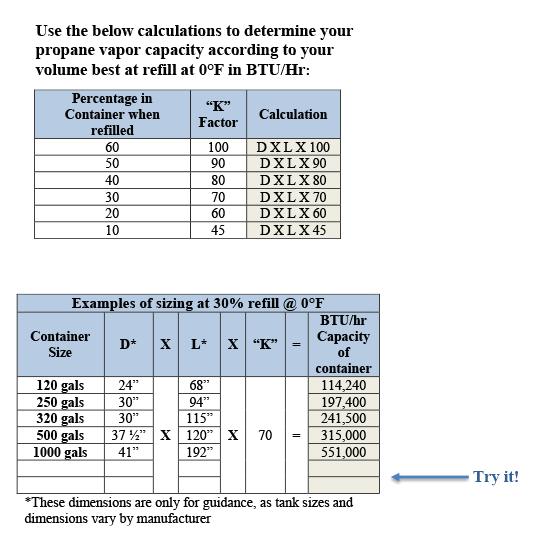
2 minute read
TECH CORNER
Properly sizing a propane tank for its application is a process that often gets overlooked. Too often propane tank choices are determined by what will fit in an available space and within current code regulations. Undersized tanks will lead to untimely issues during the coldest of weather and oversized tank sets are a tremendous waste of valuable resources, time, and mone.
When I think of improperly sized propane tanks, generators are the first scenario that comes to mind. Propane tanks are quite often undersized if the homeowner is purchasing the tanks and sometimes oversized if the fuel company is providing the tank, even with a usage fee.
Advertisement
We all also encounter propane customers who insist they need a 1,000-gallon tank to run their 100,000 btu boiler, cook stove and dryer. This may make sense if you can only deliver once a year, but if the property is easily accessible the proper size calculations can help to show what size tank is adequate and how long it can last.
Taking as much time to evaluate tank sizing as is taken to look at tank placement can help avoid many issues down the road. Educating a customer about what is needed can help create greater trust and security as the relationship develops.
RegO has provided a Field Topic which outlines the importance of proper propane tank sizing and a basic method of properly sizing. Be sure to check propane manufacturer spec to get the proper dimensions and to account for a worst-case temperature scenario.
Determining Propane Vapor Capacity
The withdrawal of propane vapor from a vessel lowers the contained pressure. This causes the liquid to “boil” in an effort to restore the pressure by generating vapor to replace that which was withdrawn. The required “latent heat of vaporization” is surrendered by the liquid and causes the temperature of the liquid to drop as a result of the heat so expended.
The heat lost due to the vaporization of the liquid is replaced by the heat in the air surrounding the container. This heat is transferred from the air through the metal surface of the vessel into the liquid. The area of the vessel in contact with vapor is not considered because the heat absorbed by the vapor is negligible. The surface area of the vessel that is bathed in liquid is known as the “wetted surface.” The greater this wetted surface, or in other words the greater the amount of liquid in the vessel, the greater the vaporization capacity of the system. A larger container would have a larger wetted surface area and therefore would have greater vaporizing capacity. If the liquid in the vessel receives heat for vaporization from the outside air, the higher the outside air temperature, the higher the vaporization rate of the system.
There are three factor that are important to properly size the LPGas storage container:
1. The total BTU load must be determined. The total load is the sum of all gas usage in the installation. Future appliances which may be installed should also be considered when planning the initial installation to eliminate the need for a later revision of piping and storage facilities.
2. The lowest percentage where refilling is best. Please follow up with your company policy and delivery manager to determine your best refill rate.
3. The coldest temperature the system will experience. Sizing to the lowest temperature condition will ensure proper operation of appliance in peak demands.
4. After gathering these factors refer to the calculation in your Rego L-545 Serviceman’s manual.










